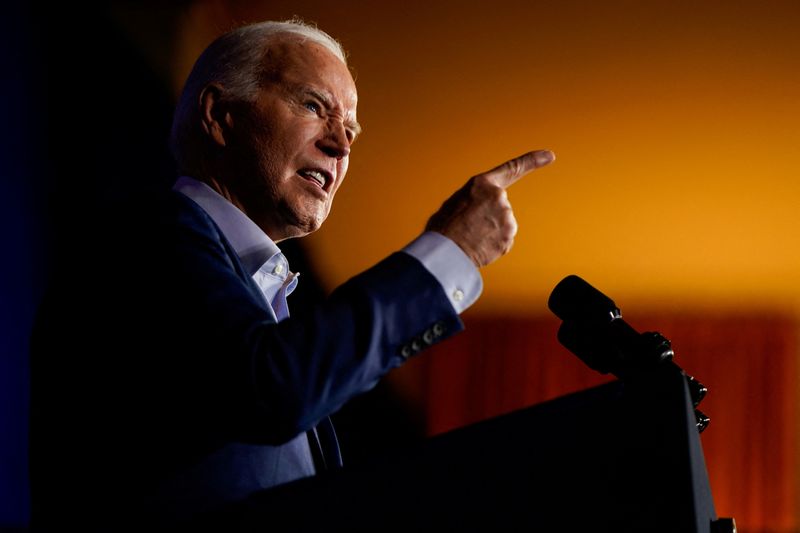Commodities
Biden to call for higher tariffs on Chinese metals in ‘Steel City’ Pittsburgh

By Trevor Hunnicutt and David Lawder
WASHINGTON (Reuters) -U.S. President Joe Biden will call on Wednesday for sharply higher tariffs on Chinese metal products as part of a package of policies aimed at pleasing steelworkers in the swing state of Pennsylvania, at the risk of angering Beijing.
In campaign stops in the “Steel City” of Pittsburgh, Biden is expected to propose raising to 25% the tariffs imposed by his predecessor Donald Trump on Chinese steel and aluminum products, according to an administration official.
The products targeted currently face up to a 7.5% levy under a Trump-era policy under Section 301 of the U.S. trade law, under a review Biden ordered in 2022.
The Biden administration is also pressuring neighboring Mexico to prohibit China from selling its metal products to the United States indirectly from there.
At the same time, it is launching an investigation into Chinese trade practices across the shipbuilding, maritime and logistics sectors, which could lead to more tariffs.
The measures, set to be unveiled as Biden visits the headquarters of the United Steelworkers union, will invite blowback from China at a time of already heightened tensions between the world’s two biggest economies.
Trump’s imposition of tariffs during his 2017-2021 presidency prompted China’s retaliation with its own levies.
Pennsylvania is one of a half-dozen battleground states likely to decide the November election rematch between Biden and Trump. The economy ranks among voters’ top concerns.
Jared Bernstein, director of the White House Council of Economic Advisers, said on Wednesday the “targeted intervention” being considered by the Biden administration should not worsen persistently high inflation.
“If we don’t take action, we’re putting at risk about one of our most critical sectors – what the president calls the backbone of the American economy, the bedrock of our national security – and that’s domestic steel production,” he told CNBC.
KEY VOTING BLOC
Biden and his Republican opponent have each courted union leaders and blue-collar workers in faded industrial hubs who comprise a significant voting bloc in Pennsylvania and Michigan, another swing state.
The steelworkers union, which sought the measures Biden is now adopting, endorsed him last month.
Biden handed the union another win when he came out last month against a proposed $14.9 billion bid by Japan’s Nippon Steel to buy U.S. Steel Corp.
Both 2024 candidates have sharply departed from the pro-trade consensus that once reigned in Washington, capped by China’s joining the World Trade Organization in 2001.
Trump, who withdrew from the would-be Trans-Pacific Partnership trade deal in 2017, has proposed a 10% tariff on all imports if he returns to office.
China was the seventh-largest exporter of steel to the U.S. in 2023, with shipments of 598,000 net tons, down 8.2% from 2022, according to U.S. Census Bureau data compiled by the American Iron and Steel Institute, an industry trade group.
Canada was the top exporter to the U.S., with 6.9 million tons, followed by Mexico, with 4.2 million tons.
Domestic steelmakers shipped 89.3 million net tons of steel in 2023, according to AISI data.
Any new levies on steel and aluminum would be subject to the approval of Biden’s appointed trade representative, Katherine Tai, at the completion of the review of the Trump-era tariffs.
The new levies would come on top of 25% Section 232 national security tariffs also imposed by Trump on steel and aluminum products and product-specific anti-dumping and anti-subsidy duties that often reach into the triple-digit percentages.
China’s economy grew by a faster-than-expected 5.3% in the first quarter, data showed on Tuesday, as the country has turned to exports to shore up growth in the face of protracted weakness in the property sector and mounting local government debt. Beijing regards Trump-era tariffs as discriminatory.
Officials said they expected Chinese exports to start flooding global markets, concerns raised by Biden Treasury Secretary Janet Yellen on a trip to the country last week.

China exported 25.8 million tons of steel products in the first quarter, the highest for the period since 2016 and a rise of 30.7% year on year, Chinese customs data showed.
“China cannot export its way to recovery,” Biden’s top economic policymaker, Lael Brainard, told reporters.
Commodities
Oil prices rise; U.S. crude inventories plunge, Russia-Ukraine truce eyed
Commodities
India’s Reliance to stop buying Venezuelan oil over US tariffs, sources say
Commodities
Oil prices climb on Venezuela supply worries

 Forex3 years ago
Forex3 years agoForex Today: the dollar is gaining strength amid gloomy sentiment at the start of the Fed’s week

 Forex3 years ago
Forex3 years agoUnbiased review of Pocket Option broker

 Forex3 years ago
Forex3 years agoDollar to pound sterling exchange rate today: Pound plummeted to its lowest since 1985

 Forex3 years ago
Forex3 years agoHow is the Australian dollar doing today?

 Cryptocurrency3 years ago
Cryptocurrency3 years agoWhat happened in the crypto market – current events today

 World3 years ago
World3 years agoWhy are modern video games an art form?

 Commodities3 years ago
Commodities3 years agoCopper continues to fall in price on expectations of lower demand in China

 Economy3 years ago
Economy3 years agoCrude oil tankers double in price due to EU anti-Russian sanctions

























